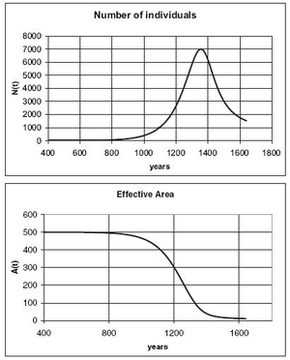February 11, 2008 feature
Model of Easter Island Collapse Might Reveal Message for Today

When a thriving civilization suddenly collapses, it’s often a mystery – and an ominous one, at that. For Easter Island circa 1000-1400 AD, experts believe it was a case of humans overexploiting their natural resources – mostly, the palm tree. But exactly where did the culturally rich Rapanui society go too far?
Researchers Mauro Bologna and J. C. Flores from the University de Tarapacá in Arica, Chile, have recently developed a mathematical model that describes the evolution – the quick rise and fall – of Easter Island during its golden age. Their model considers the interaction between natural resources and population, and generates a close estimation of the civilization’s collapse time, which can be applied to other similar civilizations.
Easter Island, located about 2,230 miles (3,600 km) off the coast of Chile in the Pacific Ocean, was, and is, one of the most isolated inhabited islands in the world. Unlike most individual societies of today or even in the past, it can be considered as a closed system.
The first settlers were thought to arrive around 400 AD from one of the other Polynesian islands to the west. Over the next 1,000 years, the Rapanui people developed a relatively advanced and complex culture. They farmed a variety of crops, built more than a thousand 30-foot-tall “moai” (stone statues), and saw their population increase to at least 7,000 (some archaeologists estimate 20,000) inhabitants.
But, as Bologna and Flores explain in their study, Easter Island’s rapid growth also meant that the society was reaching the “carrying capacity” of its ecosystem. In other words, the isolated island could no longer support its human inhabitants. The Rapanui continued to cut down the island’s palm trees – which once covered nearly the entire 160-km2-island – at a steady rate, heedless to the long-term effects.
Using their model, Bologna and Flores could determine the civilization’s equilibrium point, where humans can coexist with the available natural resources indefinitely. However, the researchers noted that a minimum number of individuals is required to maintain a population, meaning some species cannot exist at all if there are too few natural resources to support their minimum size. In the researchers’ model, this requirement is the collapse condition of an isolated civilization with a primitive level of technology.
The researchers estimate that Easter Island’s equilibrium population size would have been about 2,000 individuals – as it was around 1175. But by 1300 – just 125 years later – the population spiked to its peak of an estimated 7,000 individuals. As part of the collapse condition, each individual requires a certain amount of natural resources. For Easter Island, the minimum number of individuals required to sustain the species was higher than the maximum number of individuals the island could provide for.
From there, it didn’t take long for the civilization to collapse. By 1225, the island had only half as many palm trees as it once had, and by 1400, there were practically none left. Consequently, the population size quickly reversed its ascent, and fell back to less than 2,000 individuals by 1600. These numbers, from Bologna and Flores’ model, are also supported by archeological data.
“Probably the relative peaceful life on the island at the beginning favored the development of the society,” Bologna explained to PhysOrg.com. “In my opinion, in general, the combination of the increase of individuals and exploitation of resources can cause many difficulties, even to a technologically advanced society.”
Whether or not these difficulties could have been avoided is complex. Bologna says that the question of whether the collapse of Easter Island was inevitable is not easy to answer.
“Surely they exhausted the most important resource (trees),” he said. “At that point, they were forced to change their lifestyle, and apparently they did it fighting among themselves instead of collaborating. Perhaps a collaboration among the several tribes could have changed the final part of the evolution of the Eastern Island society. Hard to say with certitude.”
Whatever the specific causes of decline were, the researchers’ model accurately describes the populations change. Further, when they applied their model to the ninth-century Copan Mayan civilization, it predicted that the population fell from 20,000 to 5,000 individuals in a period of 60 to 180 years – closely matching with historical estimates of about 100 years. Perhaps even more interesting are the implications that the model could have for our world today.
“Professor Flores and I, we think that the model could be, with the opportune changes, applied to the planet,” Bologna said. “Of course there are many differences, but surely the planet can be considered an isolated system as Eastern Island was. Professor Flores and I hope to work on this topic in the near future.”
More information: Bologna, M. and Flores, J. C. “A simple mathematical model of society collapse applied to Easter Island.” EPL, 81 (2008) 48006.
Copyright 2008 PhysOrg.com.
All rights reserved. This material may not be published, broadcast, rewritten or redistributed in whole or part without the express written permission of PhysOrg.com.





















